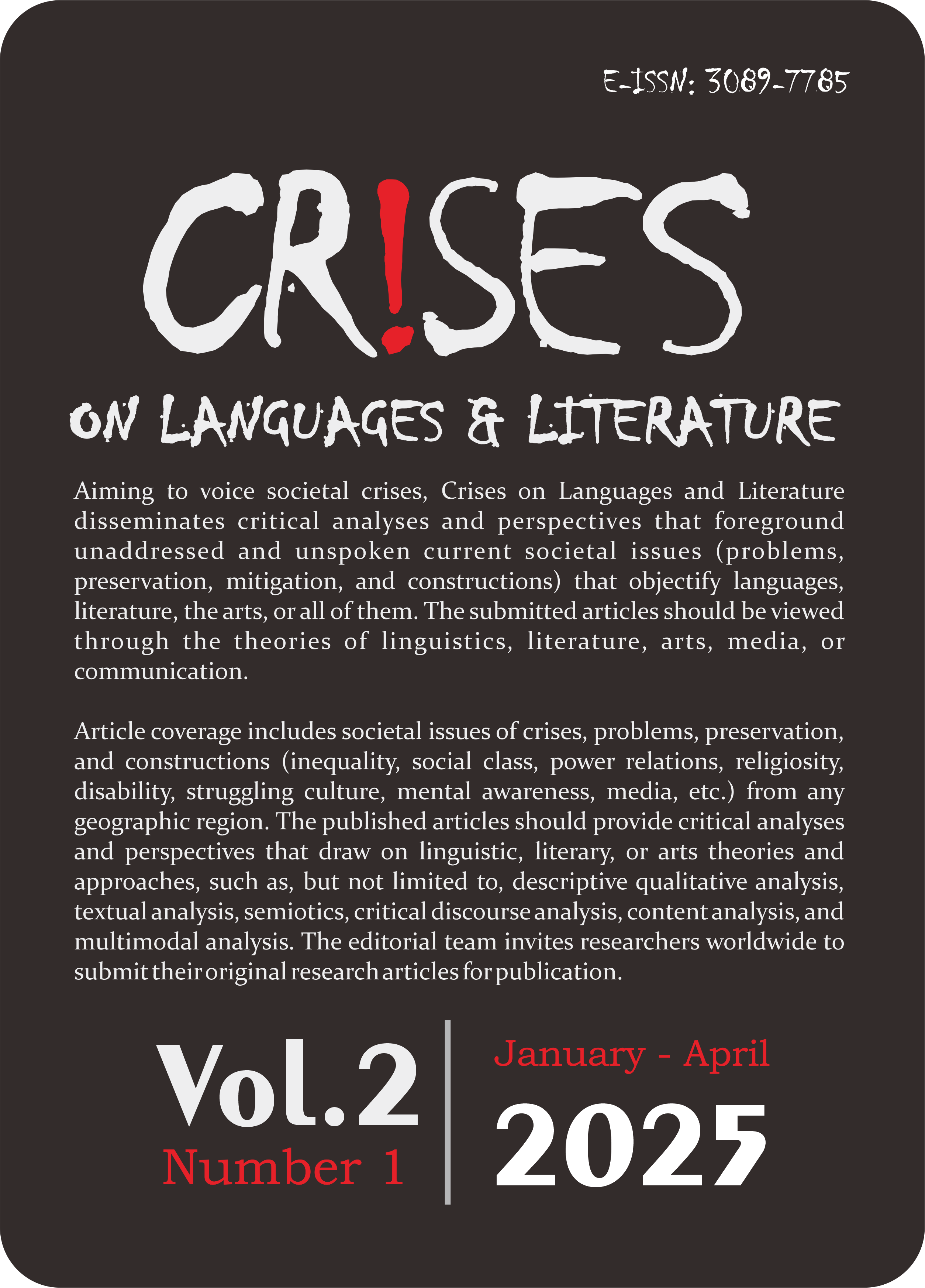Perbedaan Ekspresi Kebahasaan Laki-laki dan Perempuan dalam Mengulas Makanan pada Vlog Kuliner di Platform Youtube
Published 2025-04-28
Keywords
- bahasa dan gender,
- bahasa youtuber,
- vlog kuliner,
- sosiolinguistik,
- media sosial
- language and gender,
- youtuber language,
- culinary vlog,
- social media sociolinguistics ...More
How to Cite
Copyright (c) 2025 Diana Sri Suryani

This work is licensed under a Creative Commons Attribution 4.0 International License.
Abstract
This study is a sociolinguistic analysis utilizing a qualitative descriptive approach. The objective is to describe the differences in how males and females express delicious tastes and review food, as well as the distinctions between formal and informal language varieties in culinary vlogs on YouTube. The data for this study were collected from six culinary vloggers: three females (Ria SW, Mgdalenaf, and Separuh Aku Lemak) and three males (Tanboy Kun, Nex Carlos, and Mamank Kuliner). The primary sources of data were three videos from each of these YouTube channels. The data were gathered using a listening and note-taking method. For data analysis, the study employed theories of language and gender proposed by Lakoff (1973), Maltz & Borker (2009), and Wardhaugh & Fuller (2015). The findings revealed notable differences in the language used by males and females when expressing delicious taste. Males tend to use the word "delicious" in a more vulgar manner, while females tend to be more polite. Additionally, men provide detailed and direct information in their food reviews, whereas women are more minimal and hesitant in their descriptions. Moreover, men frequently use informal pronouns to convey solidarity, while women opt for formal pronouns and demonstrate greater politeness when reviewing food in their culinary vlogs.
References
- Alifa, F., Radha, S., Ismatul, K. (2020). A Study of Gender Differences on Food Reviewing: A Systemic Functional Grammar Approach. Proceedings of the Brawijaya International Conference on Multidisciplinary Sciences and Technology (BICMST 2020). Advances in Social Science, Education and Humanities Research, Vol. 456. Atlantis Press.
- Björk, P., & Kauppinen-Räisánen, H. (2016). Local food: a source for destination attraction. International Journal of Contemporary Hospitality Management, 28(1), 177– 194.
- Briliana, V., Ruswidiono, W., Deitiana, T. (2020). Do Millennials Believe in Food Vlogger Reviews? A Study of Food Vlogs as a Source of Information. Journal of Management and Marketing Review, 5 (3), 170-178.
- Briliana, V., Ruswidiono, W., Deitiana, T. (2020). How Social Media are Successfully Transforming the Marketing of Local Street Food to Better Serve the Constantly-Connected Digital Consumer. Proceedings of the Ninth International Conference on Entrepreneurship and Business Management (ICEBM 2020). Advances in Economics, Business and Management Research, Vol. 174. Atlantis Press.
- Chaer, A. (2013). Pengantar Semantik Bahasa Indonesia. Jakarta: Rineka Cipta.
- Donneli, E. (2023). Pengaruh Food Vloggers pada Niat Beli di Media Sosial. Mamen (Jurnal Manajemen), 2 (2), 209-221. DOI: 10.55123/mamen.v2i2.1787.
- Evelina, L.W., & Safitri, Y. (2021). Utilization of YouTube Social Communication Networking in Establishing Indonesian Street Food Opinion. Jurnal Komunikasi Ikatan Sarjana Komunikasi Indonesia, Vol. 6 (1), 2021, 44-52.
- Fakhruddin, W.F.W.W., & Salim, M.A.M. (2023). Fostering The Indonesian Culinary Through Language and Visual on Social Media: Tourism Discourse Perspective. PUSAKA: Journal of Tourism, Hospitality, Travel and Business Event, 5 (2), 106-117.
- Ghosh, A., Ravichandran, S. (2022). Role of vlogs in promoting gastronomic tourism in India postCOVID-19. In: Chowdhary, N., Billa, S., Tiwari, P. (eds.) Indian Tourism, pp. 83–96. Bingley: Emerald.
- Henriksen, D., Hoelting, M., & the Deep-Play Research Group. (2016). A Systems View of Creativity in a YouTube World. TechTrends, 60(2), 102–106. https://doi.org/10.1007/s11528-016-0047-2.
- Ilmi, Assayidah B.I. & Arimi, Sailal. (2023). Speech Features in Food Endorsement by Indonesian Influencers: a Study of Language and Gender. Suar Betang, 18(1), 65-78. https://doi.org/10.26499/surbet.v18i1.4457
- Indarti, D. (2023). Gue, Saya, Aku, Kita: Person Deictic Comparison Between Male and Female Indonesian Food Vloggers, JOLLT Journal of Languages and Language Teaching, 11(2), pp. 275-285. DOI: https://doi.org/10.33394/jollt.v%vi%i.6975.
- Lacsina, N. E. (2023). Unveiling the Art of Food Vlogging: A Multimodal Discourse Analysis of Food Review Vlogs. International Journal of Linguistics and Translation Studies 4(2).11-25. https://doi.org/10.36892/ijlts.v4i2.319.
- Lakoff, R. (1973). Language and Woman’s Place. Language in Society, 2 (1), 45-80.
- Lavis, A. (2017). Food porn, pro-anorexia and the viscerality of virtual affect: exploring eating in cyberspace. Geoforum, 84, 198-205.
- Lee, W., & Gretzel, U. (2012). Designing persuasive destination websites: A mental imagery processing perspective. Tourism Management, 33(5), 1270–1280.https://doi.org/https://doi.org/10.1016/j.tourman.2 01 1.10.012
- Li, W., Kim, Y.R., & Scarles, C. (2023). What Makes People So Fond of Food Travel Vlogs? A Preliminary Study. Proceedings of the ENTER 2023 eTourism Conference. Springer Proceedings in Business and Economics, 154-159.
- Lupton, D. (2017). Digital media and body weight, shape, and size: an introduction and review. Fat Studies, 6(2), 119-134.
- Lupton, D. (2020). Carnivalesque Food Videos: Excess, Gender and Affect on YouTube. Digital Food Cultures, Routledge.
- Maltz, D., and Borker, R. (2009). “A cultural approach to male-female communication,” in Gumperz, J., Ed. Language and Social Identity, 196-216. Cambridge.
- Nadkarni, A., & Hofmann, S. G. (2012). Why do people use Facebook? Personality and Individual Differences, 52(3), 243-249.
- Osgood, N. A. (2017). Finding the purpose of tasty videos according to social media audiences. Elon Journal of Undergraduate Research in Communications, 8(2), 88-95.
- Putri, A., Rahmadayani, R.D., Febriana, I. (2023). Analisis Penggunaan Bahasa Slang pada Konten Youtube TS Media “Shenina Cinnamon: Harusnya Sesama Perempuan Saling Support”. Jurnal Bahasa dan Sastra Indonesia, 3 (1), 32-39.
- Syahputra, F.P., & Widayarti, U.T. (2023). Hyperbole and Personification Used by Food Reviewers on TikTok Application as Promotion Strategy. Journal Business Administration, 2 (2), 57-64.
- Tanne, D. (1990). You Just Don’t Understand: Women and Men in Conversation, New York: HarperCollins.
- Wardhaugh, R., & Fuller, J.M. (2015). An Introduction To Sociolinguistics 7th Edition. New York: John Wiley & Sons, Inc.

